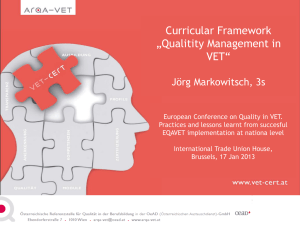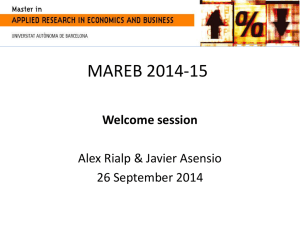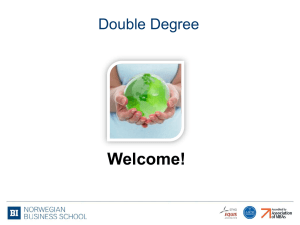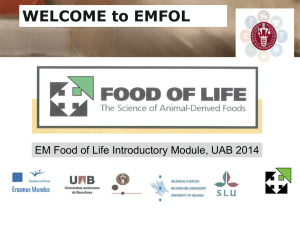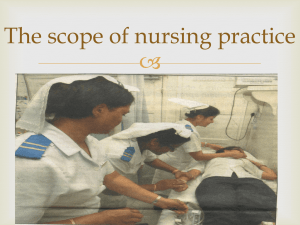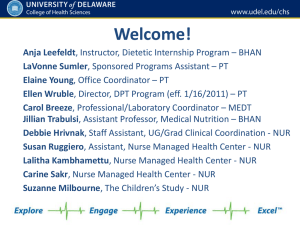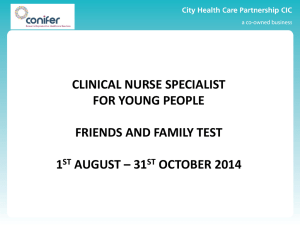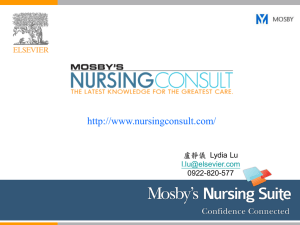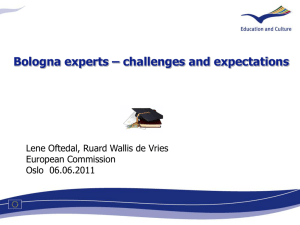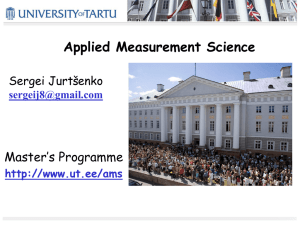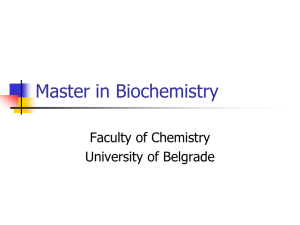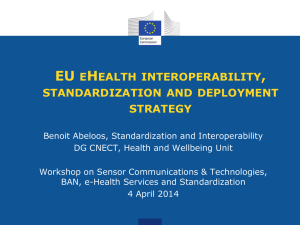eHealth in Finnish Nurse Education - Case Savonia UAS
advertisement
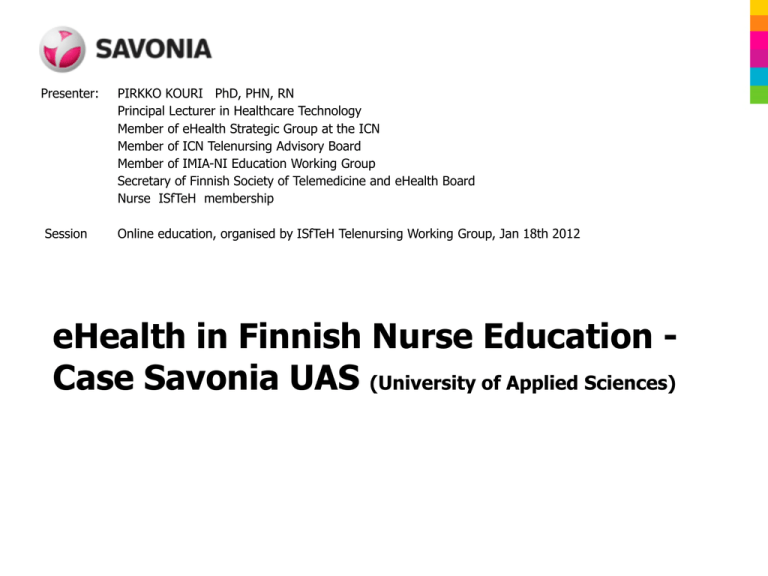
Presenter: Session PIRKKO KOURI PhD, PHN, RN Principal Lecturer in Healthcare Technology Member of eHealth Strategic Group at the ICN Member of ICN Telenursing Advisory Board Member of IMIA-NI Education Working Group Secretary of Finnish Society of Telemedicine and eHealth Board Nurse ISfTeH membership Online education, organised by ISfTeH Telenursing Working Group, Jan 18th 2012 eHealth in Finnish Nurse Education Case Savonia UAS (University of Applied Sciences) Contents • Background – Higher education in Finland • eHealth in Bachelor Level Nurse Education • Master’s Degree in Health and Welfare Technology • SaWe – project 2 Professional higher education - Dual system in Finland Doctoral degrees & Licenciate degrees Master’s degree Master’s degree Work experience 1-3 years Bachelor’s degrees Bachelor’s degrees (’Theoretical’) Universities Universities of Applied Sciences Work experience Matriculation examination General upper secondary schools Vocational qualifications Vocational institutes and apprenticeship training Additional basic education Specialist vocational qualifications Further vocational qualifications Work experience Basic education (comprehensive schools) 7-16 year-olds Pre-primary education, 6-year-olds Whole Savonia University of Applied Sciences was audited and awarded Nov 2011 UNIT OF HEALTH CARE Got a Recognized for Excellence status by Excellence of Finland Nov 11th 2010 given by the President of Finland Recognition criteria were based on high level education and implementation/results of EFQM model EFQM = European Foundation for Quality Management Nurse - Unit of Health Care In Bachelor’s level 210 ECTS • Degree Programme in Nursing: Registered Nurse 3,5 years (210 ECTS) Public Health Nurse 4 years (240 ECTS) (nurse education built in) Midwife 4,5 years (270 ECTS) (nurse education built in) In Master’s level, 90 ECTS • • Degree Programme of Health and Welfare Technology Management and Development Education Programme for Healthcare professionals 5 Overall Structure of Nurse Studies • Theoretical studies 120 ECTS – Basic studies, 38 ECTS – Subject specific 76 ECTS – Elective studies 6 ECTS • Practical studies 90 ECTS, including Thesis 15 ECTS • One ECTS means 27 hours student work, 23 h teacher work 6 Teaching/learning methods in Open Innovation Space (OIS model) • Blended learning (BL) BL -systems combine face-to-face instruction with computer-mediated instruction Integration in many ways: forms of knowledge and/or actions; teaching methods; web-based and f2f, theoretical and practice, synchronous and asynchronous, learning together or self-study • Class-room teaching • eLearning/eTeaching in web-based environment (MOODLE in use) • Social media • Student participation (versatile groups, peers, self-study) • Mobile phones used in tutoring students 7 eHealth in Nurse education 1/2 • Overall ICT usage in Learning skills (2 ECTS) – Library – Student services and social services for the students – Peer tutoring – Career plan tools (e.g Jobstep.net) 8 eHealth in Nurse education 2/2 • Nursing information management 4 ECTS • Legislation of EPR (documentation, management, conservation) • Nursing Plan, Classifications, especially FINCC • Pegasos-Electronic patient record system • Legislation related to data security and data protection (in healthcare) • Web services in healthcare and EPR as part of seamless service chain • Special course included ’Data security in Kuopio University Hospital’ 9 Master in Health and Welfare Technology (HWT studies) - 90 ECTS, 3yrs - Relatively new second cycle degree leading to master’s degree, first testing phase and based on results the law was launched 01.08.2005 10 HWT studies, multidiciplinary • Minimum of three years of relevant work experience acquired after graduation • Students from social/health care field study 90 ECTS (Students from engineering study 60 ECTS) • 12/2005 latest course for both nursing and engineering field (each field has its own students, but teaching is arranged in cooperation) --------------------------------------------------------------------------------------------------• 8/2008 first course only for social and health care field • 8/2011 newest course which is very heterogeneous (nurses, social workers, Bachelor of Business Administration, Bachelor of Beauty and Cosmetics) • Teachers from various fields 11 Objectives of HWT studies • • Education is a ’response’ to the needs of Information Society Education planned in cooperation with working life • • Encourages to practice based research and development Based on personal learning goals • Education combines both (ICT) technology and social+health care know-how in a productive way Education gives modern networking skills for multidisciplinary ICT development groups (shared expertise) • • • Education is based on competences gained after HWT studies Supports lifelong learning • The programme is adaptable internationally 12 HWT studies 90 ECTS => Master of Health Care HIGHER PROFESSIONAL STUDIES 55 ECTS SPCECIAL COMPETENCES: ORIENTATION 6 ECTS Orientation to Health and Welfare Technology Studies 6 ECTS HWT Competence, M&R&D OPTIONAL STUDIES 5 ECTS competence, THESIS 30 ECTS Councelling competence HWT COMPETENCE 20 ECTS MANAGEMENT AND DEVELOPMENT COMPETENCE 20 ECTS COUNCELLING COMPETENCE 12 ECTS Data Networks and Data Security 5 ECTS Research methodology 5 ECTS Evidence based actions in Health and Welfare areas 5 ECTS Life span of information systems and project management 7 ECTS Competence in personnel policy strategy 5 ECTS Standardization of HWT Applications 5 ECTS Anticipation and developing methods in leading 5 ECTS PUBLISHED THESIS Use of Social Media in Promotion of Health and Welfare 7 ECTS Project Management 5 ECTS 13 EU founded project: SaWe – To become a competent nurse in networks and nets, 2010 - 2013 • Length of studies 3,5 / 210 ECTS • Group: – Consists of 39 students – Educational background: Upper secondary education in the healthcare field e.g. practical nurse/assistant nurse, mental nurse, ambulanceman – Three years working experience 14 SaWe project • The aims of the project are: – To develop an innovative education model to adult nursing learners in collaboration with health care personnel • 30 days of contact teaching / year, web-based learning, ePersonal learning plan – To construct a model which combines nursing students’ learning with development of health care practices • All tutoring is carried out via personal blogs • MOODLE, Google docs, Google sites, Adobe Connect pro in use, simulations 15 In the background of the planning of the new kind of nursing education there was A need • to rise to the challenges of both health care organisations and nursing education: The complex demands of practice calls for better educated nursing professionals An urgent demand for radical changes in nursing education 16 Blended learning in the simplest way can be defined …as an integration of traditional face-to-face and online approaches to education 17 Blended learning curriculum design S o c i a l M e d i a Face-to-face and online teaching, coaching and consulting Assessment Remembering Face-to-face learning Face-to-face learning Face-to-face learning Understanding Applying Self-guided learning in groups and individually Self-guided learning in groups and individually Analyzing Evaluating Creating Learning in work places, practical training 18 In the programme: • the learning tasks that combine theoretical knowledge to practical problem solving in authentic situations • the students are triggered to reflect critically their performance and progress • the learning tasks where the students are forced to use both theoretical and practical knowledge and they have to reflect on the process and result • the students have practical training periods that have been planned according to their personal learning and development planning 19 Student evaluation after one year of studi: The positive aspects of the education have been: • An opportunity to study while working • A grown-up learning environment • A developed sense of solidarity “While we are not studying physically in the same environment, we have, because of our learning environment, very deep sense of fellowship and solidarity in this group” • A heightened self-awareness – “it’s been encouraging to notice that you are still able to learn although you are not young any more” 20 The negative aspects of the education • Lack of time – “it is sometimes difficult to find time for both work, family and studying” Number of contact days – “A low number of contact days, I would like to have more “oldfashioned” teaching • Difficulties in using technology especially at the beginning of studies 21 Thank you for your attension! Impressions from North Savo in the winter time… 22
